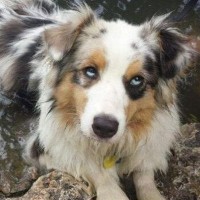Appearance of the Confetti Australian Shepherd
|
| The Confetti Australian Shepherd's physical appearance will be a combination of Australian Shepherd and Miniature Schnauzer characteristics. Therefore, to determine what your hybrid breed will look like, we need to consider the appearance of the parent breeds. The Australian Shepherd is a small, square-shaped dog. They have bushy eyebrows and beards, and deep-set eyes. Their small ears, which will be cropped or pricked, are set high and V-shaped. Their rectangular heads have small, blunt muzzles, and cropped tails are pricked and set high. Australian Shepherds are medium-sized, with a body that's not as big as the dog is long. They have hanging ears and ponytails, with deep chests. Their muzzles are tapered and will be similar in length to the head. Their eyes, which can be of different colors, are medium-sized and oval-shaped. Triangular ears are erect and set high. |
Temperament of the Confetti Australian Shepherd
|
| This breed is very alert and would do well as a watchdog. They are also highly intelligent and should be a pleasure to train. The Confetti Australian Shepherd is a social and loyal dog that will live well in a home with older children. They can sometimes be aggressive, so proper training and socialization are important for this breed. They respond best to kind but firm and consistent owners. Just as the parent Miniature Schnauzer breed can be mischievous and highly intelligent, your hybrid can be stubborn and independent, and sometimes training will be a little difficult. They can also get bored easily, so try to keep training sessions short and varied. They are very active and will enjoy exercising with their owners. This breed is suitable for anyone, even if they have no previous experience with dog ownership. This hybrid is an alert dog that can keep an eye on the house, and is better suited to homes with older children than to toddlers. The Australian Shepherd parent can have a variable personality. These dogs will be anywhere between friendly and outgoing, reserved and shy. They are always loyal and highly intelligent, and love spending time with active families. They are easy to train, as they love to please their owners. |
Needs and activities of the Confetti Australian Shepherd
|
| Like its parents, this breed is very active. Miniature Schnauzers love activities like Terrier shows. They're also good at agility, just like Australian Shepherds. Australians can become destructive or develop separation anxiety if left alone with too much energy, so it's important to give them the exercise they need. The Confetti Australian Shepherd will probably need around 30 to 80 minutes of exercise a day. |
Maintenance of the Confetti Australian Shepherd
|
| Dwarf Schnauzers will need to be well groomed every five to eight weeks to keep their coats in tip-top condition. This can be a difficult process, which is why most owners choose to enlist the help of a professional. On top of this, these dogs, which don't shed but will need their fur brushed, need to be brushed two or three times a week, and extra care needs to be given to the beard, such as washing it after eating. Australian Shepherds, which shed all year round, should be brushed weekly, or more often during peak shedding seasons. Your hybrid's grooming needs will be determined by the dominant parent. The Confetti Australian Shepherd won't need regular baths, only if they're dirty or smelly. All dogs should have their teeth brushed every day, or at least two or three times a week. Clean your dog's ears weekly to prevent infection, and trim nails as needed. This may be once or twice a month, but can vary if your dog is active and wears nails naturally. |









 English (United Kingdom)
English (United Kingdom)